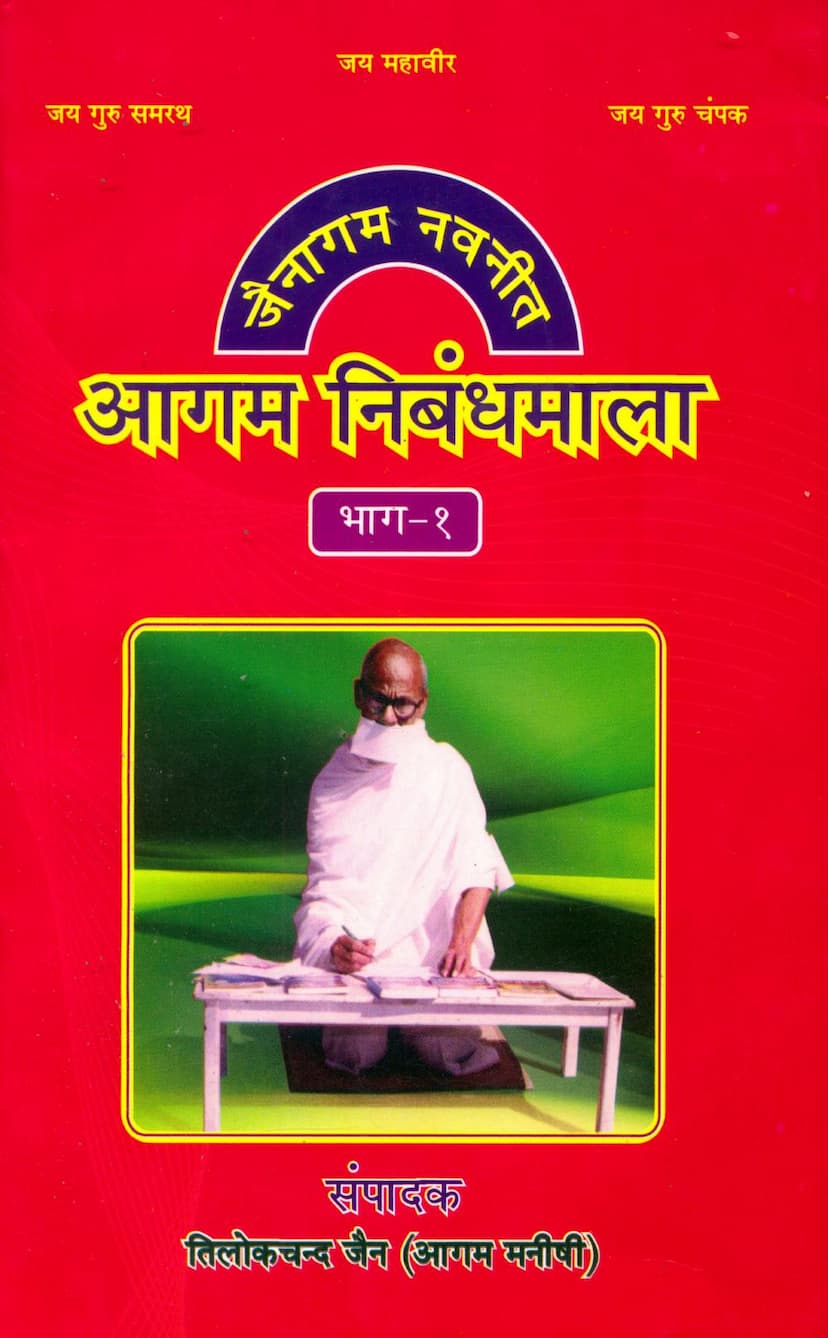Agam Nimbandhmala Part 01
Added to library: September 1, 2025

Summary
This is a comprehensive summary of the Jain text "Agam Nimbandhmala Part 01" by Tilokchand Jain, based on the provided pages.
Book Title: Agam Nimbandhmala Part 01 Author: Tilokchand Jain (Agam Manishī) Publisher: Jainagam Navneet Prakashan Samiti, Rajkot
Overall Purpose and Scope:
The "Agam Nimbandhmala" is a collection of essays and discussions based on Jain Agamas, aiming to provide in-depth knowledge and clarification on various aspects of Jain philosophy, conduct, and history. This first part focuses on foundational concepts, traditions, and the practical application of Agamic teachings. The author, Tilokchand Jain, is presented as an "Agam Manishī" (an erudite scholar of Agamas), indicating a deep and scholarly approach to the subject matter.
Key Themes and Contents (as indicated by the provided pages):
The book appears to be a multi-volume series, with this being the first part. The catalog link suggests a focus on Agamic literature. The provided pages reveal the following key areas covered:
-
Introduction and Editorial: The preface highlights the purpose of the "Agam Nimbandhmala" as a continuation of earlier works like "Agam Saransh" and "Agam Prashnottar." It aims to present Agamic topics in an essay format for the benefit of readers, writers, publishers, and seekers of spiritual upliftment. The editor expresses hope that this series will be well-received and beneficial. The first part specifically aims to cover essays related to the Jain tradition and lineage, self-control, initiation and teaching, organizational structure, penance, conduct, practices, and the state of karma.
-
Table of Contents (Partial): The included table of contents (Pages 11-12) provides a detailed list of essays within this volume. These essays cover a wide range of topics, including:
- Philosophical and Doctrinal: Navkar Mantra analysis, history of Jain Agamas, principles of Jainism, karma theory, concept of 'Pasattha' (those with external focus), concepts of 'Shiithilachar' (laxity) and 'Shuddhachar' (correct conduct).
- Monastic Conduct and Discipline: Eligibility and duties of initiates and preceptors, responsibilities of Acharyas and disciples, the necessity of the Acharya position, qualities of different monastic orders ('Nigranthas'), the process of self-examination for ascetics, the nature of 'Sanyam' (restraint), and various types of penance.
- Agamic Literature and Tradition: Origin and lineage of Jain Agamas, historical context of Lord Mahavir's teachings, the transmission of Agamic knowledge through generations, the impact of external factors on the preservation of Agamas, and the different traditions within Jainism (e.g., Shvetambara).
- Ethical and Social Aspects: Language and its appropriate use in Jain teachings, personal conduct, purity of character, the distinction between 'Vandaniya' (worthy of reverence) and 'Avandaniya' (unworthy of reverence), and the resolution of doubts related to laxity.
- Specific Agamic Concepts: Detailed analysis of various rules and vows (e.g., '14 Niyam', '12 Vrat'), daily observances ('Samayik Sutra'), and expiations ('Prayaschitta').
- Historical and Critical Analysis: Discussion on the authenticity and interpretation of Agamic texts, critiquing certain later additions or interpretations that deviate from the original teachings. The text also touches upon historical debates within Jainism, particularly regarding the scriptures of different sects.
-
Specific Essay Content (Examples from the provided text):
- Essay 1: Navkar Mantra: A detailed explanation of the Navkar Mantra, its origin, authorship, and refutation of the idea that the second stanza ('Chūlikā') is a later addition. It emphasizes the integral nature of the entire mantra as part of the foundational 'Āvaśyak Sūtra'.
- Essay 2: Jain History: Discusses the importance of history in understanding Jain philosophy and critiques the potential for distortions and fabrications in historical accounts due to the passage of time and lack of early documentation.
- Essay 3: Language and Conduct: Explores the appropriate use of language, arguing that Jain scriptures sometimes employ strong or critical language to convey truth and correct deviations.
- Essay 4 & 5: Agamic Origin, Tradition, and History: Delves into the origins of the Agamas, their transmission, historical periods of scriptural compilation, and the challenges faced in preserving this knowledge. It also addresses the divergence between Shvetambara and Digambara interpretations of scripture.
- Essay 6 & onwards: The latter part of the provided text delves into detailed analyses of monastic conduct, classification of monks ('Nigranthas' into various categories like Pulak, Bakush, Pratisevana Kushil, Kashaya Kushil, Nirgrantha, Snātaka), and the specific rules and prohibitions related to their behavior ('Āchār', 'Samāchār', 'Vichar'). The essays also cover topics like the qualifications of ascetics and teachers, the importance of discipline, penance, and the interpretation of various Agamic injunctions. The text frequently references specific Agamic sources like 'Nishīth Sūtra', 'Āchārāṅga Sūtra', 'Daśavaikālika Sūtra', 'Uttarādhyayana Sūtra', and 'Bhagavatī Sūtra' to support its arguments.
-
Author's Stance and Approach: Tilokchand Jain's writing style is characterized by its scholarly depth, reliance on Agamic texts, and a critical yet respectful approach to understanding Jain traditions. He often addresses contemporary issues and debates within the Jain community, providing an Agamic perspective. There's a discernible effort to clarify complex doctrines and practices, often by drawing parallels and distinctions between different interpretations or traditions.
Overall Impression:
"Agam Nimbandhmala Part 01" appears to be a valuable resource for anyone seeking a deeper understanding of Jain Agamas and their underlying principles. It is likely aimed at dedicated Jain scholars, practitioners, and students who wish to engage with the scriptural foundations of their faith in a comprehensive and analytical manner. The work emphasizes the importance of adhering to the core principles laid down in the Agamas, while also engaging with the historical and practical aspects of Jain life and practice.